Where to put powder in the washing machine and how much powder to pour: balance of efficiency and economy
The washing machine has long been a loyal assistant to housewives. In order for the processing of linen to please its results, it is necessary to strictly observe the operating rules. First of all, you need to know where to put the powder in the washing machine and how much money is needed to carry out normal washing.
In the article we presented, it is described in detail where and in what order should be loaded laundry detergent. We will show you how to choose the optimal composition for removing contaminants from processed items and how to choose the proportions. Compliance with our recommendations will help to competently operate washing equipment.
The content of the article:
Rules for the use of detergents
Most often, in modern units, powdered products having a different composition are used. They can be fully or partially synthetic, concentrated, made from soap or herbal extracts, however, the inscription “for automatic washing” must be inscribed on their packaging.
Where should I wash the detergent?
It is strongly discouraged to use preparations for manual processing of linen: they cause severe foaming, which can lead to clogging of the hose and, as a result, to leaks.
Pouring powder into different types of washing devices is done in different ways. At semi-automatic machines usually there is no separate detergent drawer; the powder is poured into the tank with the laundry.
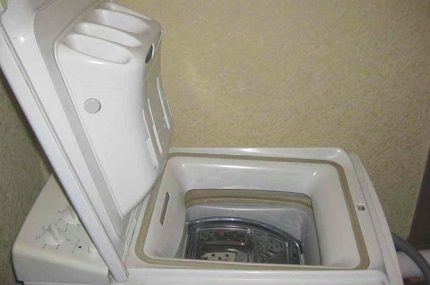
In machines with vertical loading, cells for powder, conditioner, bleach are located on the inside of the hatch located at the top.
For frontal washers, the detergent drawer is usually located in the upper left corner. Depending on the brand, its design may vary.
Let us consider in more detail the design of the powder tray. A retractable cuvette designed to allow detergent to enter the drum has a well-thought out device. As a rule, it is made of plastic: the front panel has a body color, and the inner surface is white or gray.
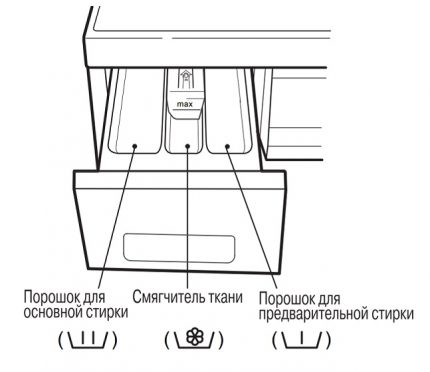
The device is divided into three, rarely four compartments, which are marked with letters, symbols, Roman or Arabic numerals:
- The biggest moduleindicated by numbers II, 2 or letter AT the product necessary for the main wash cycle is filled up.
- Medium Compartment, numbers are applied on it I, 1 either letter AND, It is designed for filling the washing powder, which is used for pre-washing the laundry. Here you can add bleach or stain remover.
- The smallest department, which is usually located on the left, is intended for filling flavorings, air conditioners. This part can be marked with numbers. III, 3in a word Softenerdepicting a flower (asterisk).
To adjust the amount of emollient, an air conditioner compartment is often covered with a limit bar labeled max to indicate the limit.
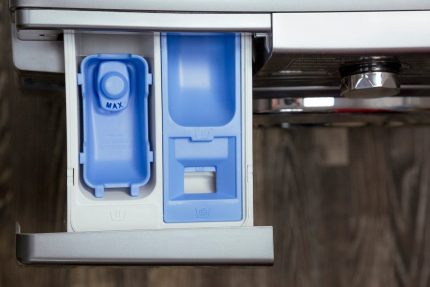
In some cases, this compartment is divided by a partition into two parts, and a removable module can also be used. One of them is provided for the conditioner itself, the second for diluted starch, flavoring or other additional substance.
Detergent loading rules
The powder in the cell is filled randomly; it is not at all necessary to distribute it evenly throughout the container: the main thing is that it does not spill over the edges. After carrying out the manipulation, the compartment must be tightly closed, and only then start the machine.
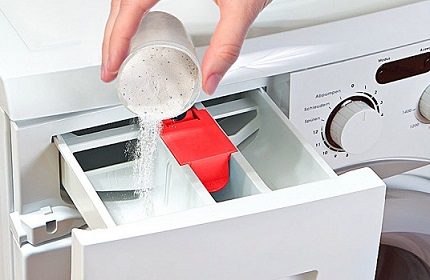
Some washers in the cells have levels that allow you to control the amount of detergent poured. However, often housewives pour powder on the eye, remembering the amount of previous washings.
The design features of the machine help to ensure that detergents (powder, conditioner) get into the drum along with the flow of water flowing through the tray. Each compartment has openings that create conditions for the dissolution of these funds with a stream of water and their transfer to the tank.
The full transport of substances is facilitated by both a high pressure under which water is supplied, and smooth walls of the powder receiving device, which facilitate the exit of the dissolved substance.
Features of loading detergent into the tank
Sometimes the question arises for the hostesses whether it is worth adding powder directly to the drum. We will analyze this question in detail.
When do we add powder to the drum?
Such a measure is necessary: it is necessary to resort to it in case of damage to the detergent tray.
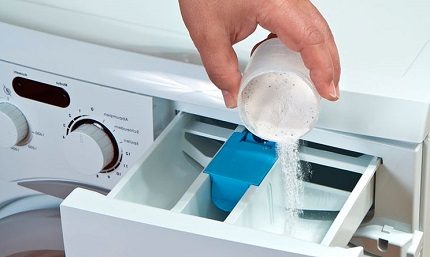
In this case, it is first of all to find out whether the compartment really does not cope with the proper functions. This can be done simply: carefully inspect the item after washing. If any residual detergent is found in it, it means that it has not been washed thoroughly due to malfunctions.
Pros and cons of an alternative method
There are various opinions regarding the addition of detergents directly to the laundry.
Supporters note the following positive aspects:
- In this case detergent can be reducedbecause it is in contact with things.
- Such method increases the life of the machine, and also saves the user from caring for the tray, which is one of the most problematic parts of washing units.
- When ingested through a cuvette, powder particles may adhere to the inner walls, and then rinse onto the laundry when rinsing. When falling asleep in the drum, this does not happen, due to which things rinse faster and better.
At the same time, a significant number of minuses are noted:
- In the compartment, the powder is washed with water, getting into the drum already partially dissolved. When adding the product directly with the laundry, it will dissolve much longer.
- Granules of washing powder falling on things of a dark color can leave light traces.
- If the product is poured onto the wall of the drum, then at start part of it will be pumped out by the pump along with the water remaining in the tank from past washings.
- Some washing programs involving the batch use of washing powder will not be available when adding funds to the drum.
- It makes no sense to add powder to the drum when planning pre-washing or soaking. Such modes involve the discharge of water after passing the initial stage; along with the liquid, the detergent dissolved in it will also leave, which will not wait for the main stage of the cycle.
- It is also impossible to use this method to add an air conditioner or other rinse aid, which should only be poured at the final stage of the process.
Partial avoidance will be made possible by the use of a special container: a plastic jar with holes on the lid. The detergent added to it will enter the water gradually and not be washed immediately.
At the same time, this method will not solve the problem of using conditioners or other rinses.
What products can be added to the laundry?
At the same time, there are a number of modern tools that, according to the advice of manufacturers, must be brought into the drum.
Such substances include:
- Soap base powders. These substances have a coarse-grained structure, which can clog a hole in the cell, which is fraught with leakage and flooding of the neighbors.
- Phosphate-free powders, as well as the means for the production of which are used plant extracts.
- Laundry Detergent Powders: Filling the drum makes rinsing easier.
- Modern varieties of detergents, available in the form of gels, capsules, compressed cubes.
Gel preparations are not recommended to be added to the cuvette: because of the thick consistency, they are slowly washed off with water.Because of this, their residues can get into the tank already at the final stage of the cycle during rinsing and spinning.
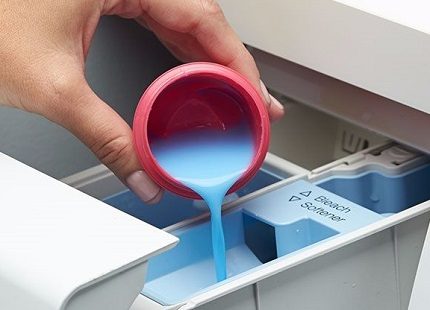
If for some reason the gels need to be added to the tray, it is recommended that you first dilute them with water. Capsules were specially designed for use in the drum, other options for their use are not provided.
All these funds can be added to the drum in different ways:
- previously diluted with water;
- pour directly on linen;
- put in a special bag (this option is especially recommended for powder based on plant materials).
Sometimes housewives have to deal with situations where it is not possible to determine the purpose of the tray compartment (erased marking and the inability to consult the instructions). In this case, it is quite possible to restore information empirically.
To do this, start the device in non-soaking mode, leaving the detergent tray ajar. If you look at the cuvette at the very beginning of the cycle, you can see how water will enter the compartment intended for washing powder.
Determining the optimal amount of funds
Depending on the selected program, when wiping products, you need to add the following funds:
- For simple washing, just pour the powder in the cell marked with the letter B or the number 2 (II).
- For a full cycle with soaking and rinsing with the addition of a softener, powder is loaded into compartments A and B, and the conditioner is poured into the tray marked with a 3 or “flower”.
- If the laundry does not have very pronounced dirt, you can do without pre-soaking. In this case, it is enough to add detergent to compartment B (II); if desired, a rinse aid is also added to the small compartment.
The conditioner (flavoring, rinsing agent) can be poured into the tray at any stage of the process until the start of the final stage (rinsing and spinning).
What affects the amount of powder?
The amount of detergent needed for washing depends primarily on the volume of products loaded into the machine.
In addition, factors such as:
- the degree of contamination of the laundry;
- hardness of water;
- amount of water required for washing;
- selected program;
- washing technology.
The more stains on the products, the higher the consumption of detergent. If the contaminants are complex, it is better to use a stain remover or bleach.
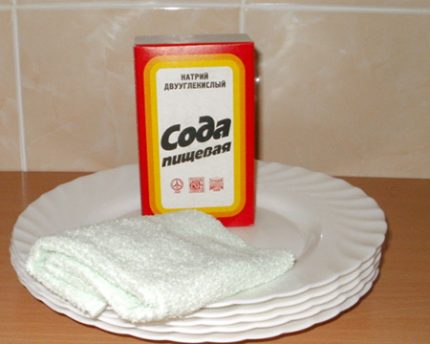
Washing in soft water requires less powder than hard water. To determine the type of water in your area, just look at the transparent window at the start of the wash. If bubbles are visible on it, then soft water flows from the taps.
The liquid can be softened artificially by adding a special agent containing phosphates to the washing powder. A large amount of water for washing involves an increased content of detergents.
Various modes include the use of a certain amount of washing powder. In some cases, the difference can be striking: for example, when washing 3 kg of laundry in the “Cotton” mode at +60 ° C, 6 tablespoons of detergent will be required, while when choosing the “Synthetics” program at +40 ° C - only three.
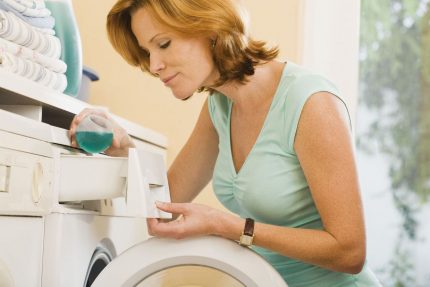
Innovative solutions used in modern models of washing machines from top manufacturers, allow to reduce the consumption of electricity, water, detergents.
These technologies include:
- “Smart bubbles” EcoBubble;
- steam wash.
In the first case, a special foam generator is used, with which the powder is mixed in water even before it enters the drum. Under the influence of bubbles, the agent penetrates better into the structure of the tissue, effectively removing impurities, which helps to save the powder.
Steam washing involves supplying a heated water stream to items placed in a drum. This technology contributes to the rapid dissolution of detergents and effective cleaning of contaminants, including obsolete ones.
In this case, the water temperature is chosen arbitrarily, it does not need to be heated to high temperatures. Among the important advantages of steam washing can be attributed to the radical destruction of microbes and allergens.
We calculate the proportions of detergent
You should not mindlessly pour into the tray washing machine household chemicals. Exceeding the norm threatens with increased foaming, which can lead to clogging of the hose and leaks. If you do not calculate the flow rate and fall asleep with a little detergent, linen can be poorly washed.
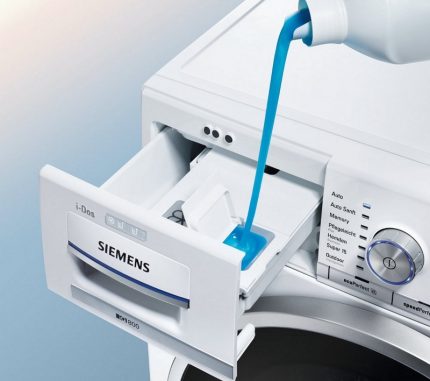
We will try to determine exactly how much washing powder should be poured into the washing machine.
As a rule, the dosage information is marked on the label of any product, and sometimes the manufacturer supplies the pack with a measuring spoon or glass. If you believe the manufacturers, washing clothes may require 115 grams, and heavily soiled items even 225 grams.
Practice shows that good washing results can be obtained using much less detergent. For slightly soiled products, it is enough to add 1 tablespoon of powder with a hill (25 g) per 1 kg of linen.
If things are very dirty or washing is carried out in very hard water, the dose is recommended to be increased to 1.5-2 tablespoons per kilogram.
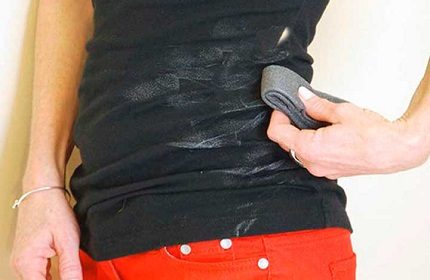
Concentrated powders are suitable for use, which include Japanese products and Amway products. Their proportions are calculated regardless of the amount of laundry loaded: for any cycle, just 2 tablespoons of this type of detergent is enough.
If you use capsules, you should be aware that one element is enough for a cycle, regardless of load.

Liquid and gel-like products are usually laid at the rate of 1 tablespoon per cycle (regardless of the volume of things), with hard water, the amount of detergent recommended is increased to 2 tablespoons.
Caring for a washing cuvette
In order for the powder collector to work properly for a long time, a number of recommendations must be followed.
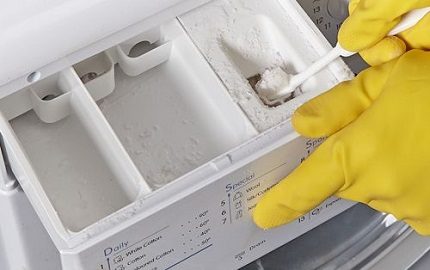
Periodically, the air conditioner must be poured into the compartment. After soaking, the cuvette is removed from the niche, and then thoroughly washed with a brush.
At the same time, the walls of the hole are cleaned, where dust and accidentally spilled powder often accumulate.
Conclusions and useful video on the topic
The video below shows how many detergents you need to add when washing in an automatic machine:
For high-quality washing of linen with a minimum expenditure of powder, a number of factors must be taken into account.
To determine the required amount of detergent, you need to take into account the amount of laundry loaded in the machine, the hardness of the water used, the degree of contamination of the products, the features of the mode selected for washing.
In addition to this, the recommended algorithm of actions should also be followed, correctly laying the detergent or other product in the cuvette intended for it.
Want to talk about how you load powder into a cuvette of a washing machine? Have a desire to share the tricks and secrets of backfill that are useful to site visitors? Please write comments, ask questions, post a photo on the topic of the article in the block form below.

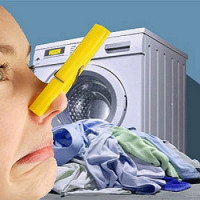 How to get rid of mold in the washing machine with improvised means at home
How to get rid of mold in the washing machine with improvised means at home 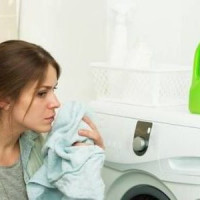 Unpleasant odor in the washing machine: causes of odor and methods for eliminating it
Unpleasant odor in the washing machine: causes of odor and methods for eliminating it 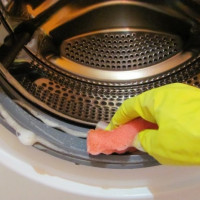 How to clean the drum in the washing machine: sequence of steps
How to clean the drum in the washing machine: sequence of steps 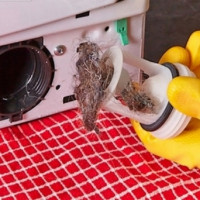 How to clean a filter in a washing machine: an overview of best practices
How to clean a filter in a washing machine: an overview of best practices 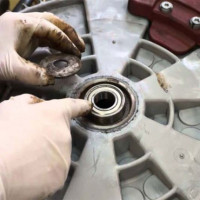 How to exchange bearings on an Indesit washing machine: step-by-step instruction
How to exchange bearings on an Indesit washing machine: step-by-step instruction 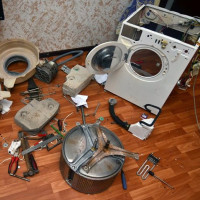 Replacing the bearing in the washing machine: how to change the bearing yourself and not make mistakes
Replacing the bearing in the washing machine: how to change the bearing yourself and not make mistakes  How much does it cost to connect gas to a private house: the price of organizing gas supply
How much does it cost to connect gas to a private house: the price of organizing gas supply  The best washing machines with dryer: model rating and customer tips
The best washing machines with dryer: model rating and customer tips  What is the color temperature of light and the nuances of choosing the temperature of the lamps to suit your needs
What is the color temperature of light and the nuances of choosing the temperature of the lamps to suit your needs  Replacement of a geyser in an apartment: replacement paperwork + basic norms and requirements
Replacement of a geyser in an apartment: replacement paperwork + basic norms and requirements
Many housewives do not particularly bother about how much powder to pour into the washing machine. After all, this depends on the amount of linen, and on the degree of pollution. I switched to washing gels, they are much more economical. In addition, they are better washed out of the tissue, but also require certain dosages, depending on the concentration of the product.
Indeed, do not neglect the recommendations on the amount of powder or other detergent, since not only the quality of washing the laundry, but also the condition of some parts of the washing machine depends on it. Namely, an important point is the preventive measures against the formation of scale on a tubular electric heater.
When washing, I use exclusively detergent and everything suits me. I do not understand these gels or liquid detergents, I tried it somehow, but did not like it. Moreover, they are not recommended to be washed at high temperatures. I usually sprinkle the powder less than indicated on the package. I think that it makes no sense to pour so much and you can save. Usually everything is well washed.